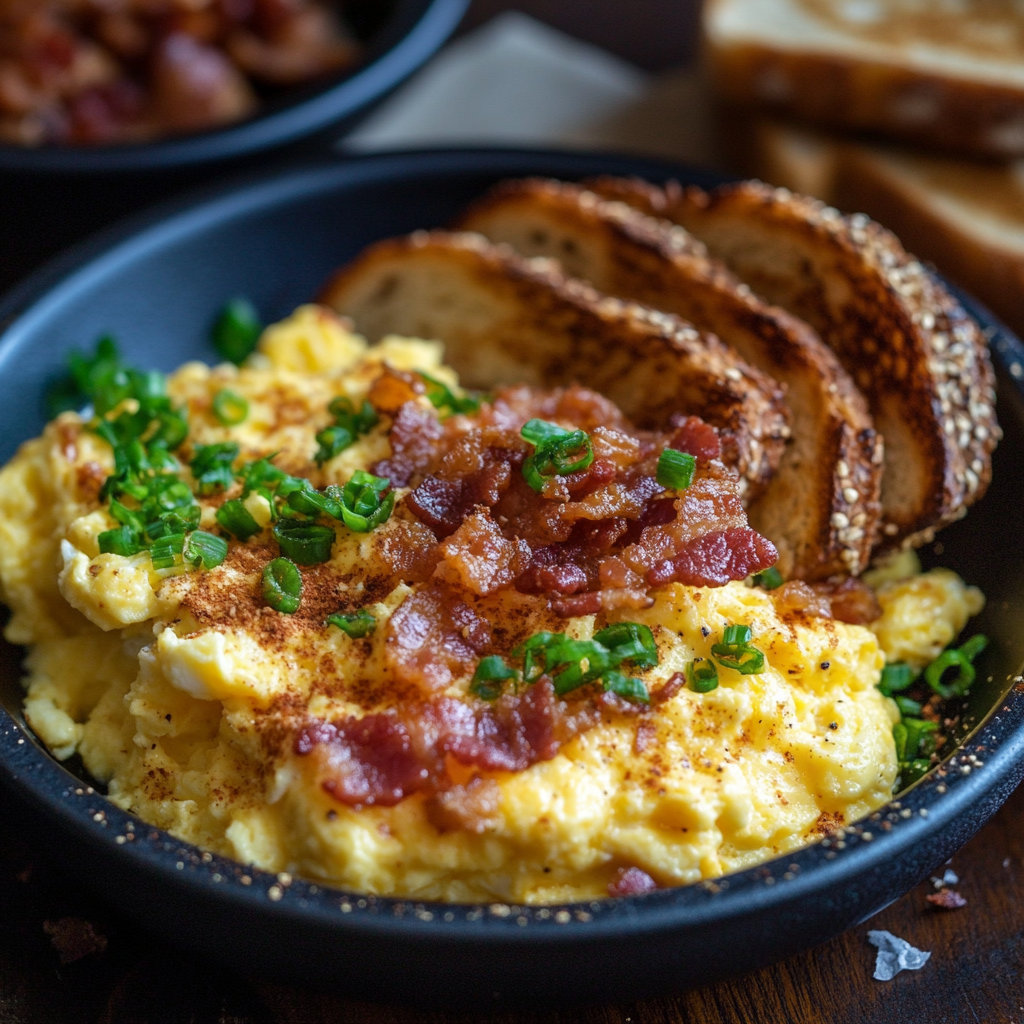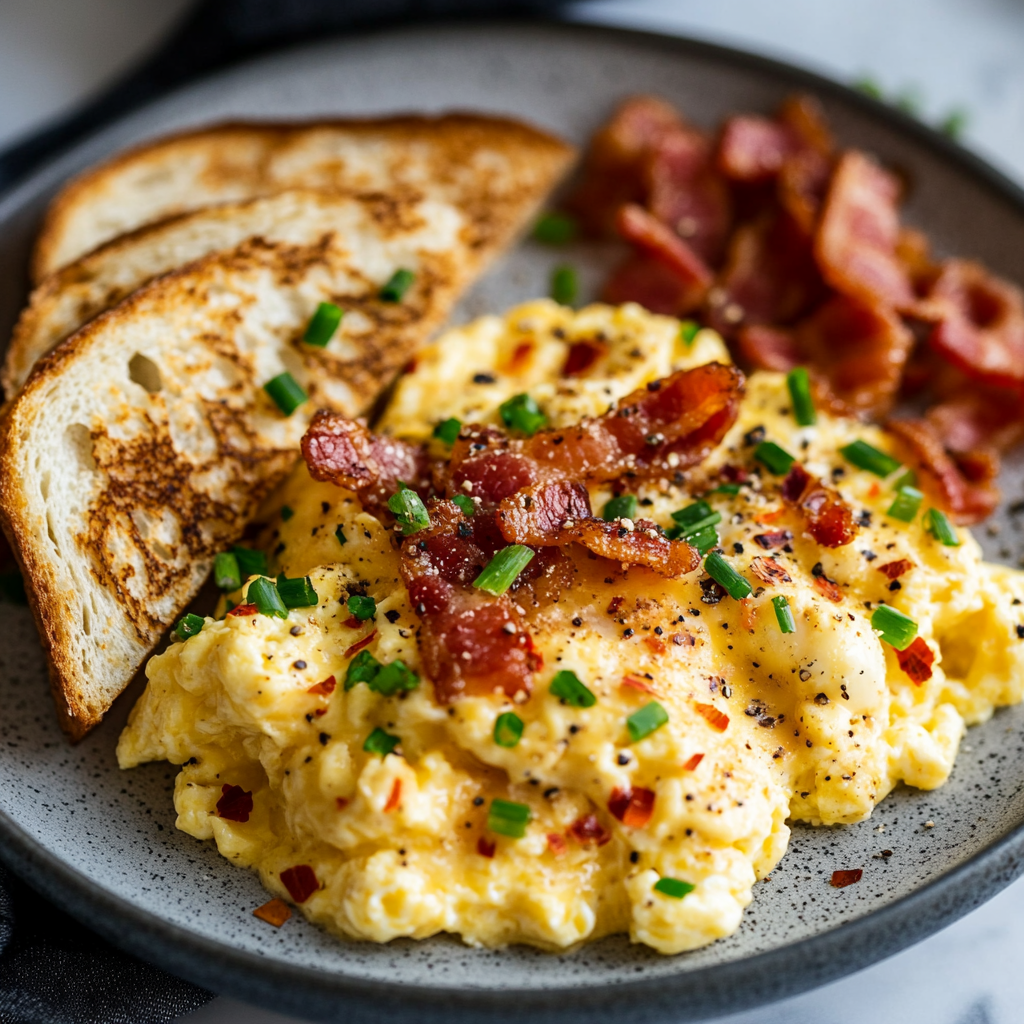Introduction
Overview of the Recipe
Cheesy scrambled eggs with crispy bacon and toast offer the perfect trifecta for a hearty breakfast. The creamy texture of the eggs, enriched with melted cheese, contrasts beautifully with the crispy crunch of the bacon, while the toast adds a warm, comforting base. This dish is a go-to favorite, perfect for any morning, whether you’re rushing to start the day or enjoying a relaxed breakfast. Its satisfying blend of textures and flavors makes it an accessible and irresistible choice, simple enough for beginners, yet delightfully indulgent for seasoned home cooks.
Why This Breakfast Stands Out
This breakfast shines because of its perfect balance between creamy, crispy, and hearty elements. The cheesy scrambled eggs are rich and velvety, while the bacon offers the satisfying crunch, and the toast completes the meal with its warm, comforting touch. Together, they create a fulfilling and timeless breakfast experience.
Brief History of Scrambled Eggs and Bacon
Scrambled eggs and bacon have long been breakfast favorites in both American and British traditions. Scrambled eggs, with their origins tracing back to the 17th century, have been a versatile morning staple. Bacon, a centuries-old favorite, has always complemented eggs, creating a hearty and satisfying combination embraced worldwide.
Key Ingredients and Their Role
Eggs
Choosing the Right Type of Eggs (Organic, Free-Range)
The foundation of any great scrambled eggs lies in the quality of the eggs used. Organic and free-range eggs are the best choices for several reasons. They tend to have richer yolks with a more vibrant color and a cleaner, fresher taste. These eggs also come from hens raised in more natural environments, avoiding the use of harmful pesticides or antibiotics. By choosing organic or free-range eggs, you’re not only supporting better animal welfare but also enhancing the overall flavor and texture of your dish.
Nutritional Benefits (Protein, Vitamins)
Eggs are a powerhouse of nutrition, providing a rich source of high-quality protein, which is vital for muscle building and repair. A single egg typically contains about 6 grams of protein, along with key vitamins like vitamin B12, which supports metabolism, and vitamin D, which is essential for bone health. Eggs also contain important minerals such as iron and zinc. Their nutrient-dense profile makes them a perfect component for a healthy, satisfying breakfast.
Cheese
Best Cheeses for Scrambled Eggs (Cheddar, Gouda, Feta, Cream Cheese)
The type of cheese you choose can elevate your scrambled eggs. Classic cheddar is a top choice, offering a sharp and tangy flavor that complements the creaminess of the eggs. Gouda, with its mild, buttery taste, brings a smooth and rich texture to the dish. For a more decadent twist, cream cheese can be mixed into the eggs, creating a velvety smooth finish. Feta, on the other hand, adds a tangy and crumbly texture that contrasts wonderfully with the softness of scrambled eggs. Each cheese variety brings its own unique flavor profile, allowing for versatility in your dish.
How Cheese Enhances Texture and Flavor
Cheese plays a critical role in both the flavor and texture of scrambled eggs. As the cheese melts, it creates a silky, creamy consistency that makes the eggs feel more indulgent. The fat in the cheese also enhances the overall richness of the eggs, creating a luxurious mouthfeel. In addition, cheese adds layers of flavor, whether it’s the sharpness of cheddar, the creaminess of cream cheese, or the savory complexity of feta, making your scrambled eggs truly stand out.
Bacon
Types of Bacon (Streaky, Back, Smoked)
Bacon is the perfect complement to scrambled eggs, offering a savory crunch that contrasts beautifully with the creamy eggs. There are different types of bacon to consider. Streaky bacon, known for its high-fat content, crisps up beautifully, adding a satisfying crunch. Back bacon is leaner and meatier, providing a different texture and flavor. Smoked bacon offers an additional depth of flavor, with a distinct smoky aroma that infuses the dish. Each variety can alter the final flavor profile, allowing you to choose according to your preference for a richer or leaner bite.
Achieving the Perfect Crispiness
To achieve perfect crispy bacon, the key is to cook it slowly over medium heat, allowing the fat to render without burning the meat. Place the bacon in a cold pan and gradually heat it, ensuring even cooking. For an extra crisp texture, avoid overcrowding the pan, and once cooked, place the bacon on paper towels to drain any excess fat. The result is perfectly crispy bacon that adds a satisfying crunch to your scrambled eggs and toast.
Bread for Toast
Ideal Bread Types (Whole Grain, Sourdough, Brioche)
The bread you choose for your toast can significantly impact the overall taste of your dish. Whole grain bread offers a hearty, nutty flavor that complements the richness of the eggs and bacon. Sourdough, with its tangy, chewy texture, contrasts beautifully with the softness of the scrambled eggs. If you want a more indulgent option, brioche provides a buttery sweetness that pairs perfectly with savory toppings like bacon and eggs, creating a more luxurious breakfast experience.
Importance of Toasting Techniques
Toasting your bread properly is essential to achieving the right texture. Toast should be golden brown with a crisp exterior while remaining soft and airy inside. For added richness, butter the toast immediately after toasting so it absorbs the melted butter, giving it a decadent finish. Properly toasted bread serves as the perfect base for your scrambled eggs and bacon, adding a satisfying crunch while enhancing the overall meal.
Step-by-Step Guide to Making the Dish
Preparation
Before diving into the cooking process, gather all the ingredients and equipment you’ll need for this delicious breakfast. Start by assembling the following:
- Ingredients: Eggs, cheese (cheddar, gouda, cream cheese, or feta), bacon, bread (whole grain, sourdough, or brioche), butter, salt, and pepper.
- Equipment: Non-stick frying pan, spatula, tongs (for bacon), a whisk or fork, a bowl for whisking eggs, and a toaster or pan for the bread.
Prepping the Bacon and Bread:
For the bacon, lay out the strips on a plate, ready to be cooked. Depending on the type of bacon you choose, this could take anywhere from 5 to 10 minutes to cook. If you’re using bread for toast, slice it to your desired thickness, typically about 1-inch thick, and set it aside for toasting. If you’re adding butter to your toast, have that ready to go as well.
Taking a few minutes to prepare your ingredients and ensure that everything is ready will make the cooking process smoother and more enjoyable. This organized prep helps you manage the timing of each component, ensuring everything comes together at once.
Cooking the Bacon
Techniques for Crispy Bacon:
The key to crispy bacon lies in slow, even cooking. There are several methods to achieve this:
- Pan-Frying: Start by placing the bacon in a cold, non-stick pan. Gradually heat the pan to medium, allowing the fat to render out and the bacon to crisp. Flip the bacon occasionally to avoid burning.
- Oven-Baking: For an even crisp, lay the bacon strips on a baking sheet lined with parchment paper. Bake at 400°F for 15-20 minutes, depending on thickness. This method allows the bacon to cook evenly without much attention.
- Air-Frying: Place the bacon in the air fryer basket at 380°F for 10-12 minutes. This method is quick and delivers perfectly crispy bacon with minimal grease.
Managing Grease for Flavor Enhancement:
As the bacon cooks, it will release fat. For the crispiest result, drain the bacon on paper towels to absorb excess grease. The bacon’s rendered fat can be saved for other recipes or used to season the eggs or toast for added flavor.
Perfecting Cheesy Scrambled Eggs
Whisking Techniques for Fluffy Eggs:
To create the fluffiest scrambled eggs, start by cracking the eggs into a bowl and whisking them vigorously with a fork or whisk. For optimal results, add a splash of milk or cream to the eggs before whisking. This adds extra moisture and helps achieve a lighter texture. Whisk until the yolks and whites are completely blended and the mixture has a slightly frothy texture. The more you whisk, the fluffier your eggs will be.
Low-and-Slow Cooking for Creaminess:
The secret to creamy scrambled eggs is cooking them on low heat. Place a non-stick pan over low heat and add a small knob of butter. Once the butter melts, pour in the eggs. Stir the eggs gently and constantly using a spatula. The eggs should move slowly around the pan in soft, smooth curds, not dry out. This process can take a few minutes, so be patient—it’s worth the wait.
Adding Cheese at the Right Time for a Melted, Smooth Finish:
As the eggs near completion, when they are still slightly runny, add your cheese. Shredded cheddar or gouda works well, as it melts beautifully into the eggs. Stir the cheese into the eggs just before they finish cooking, ensuring it melts evenly and combines seamlessly for a creamy, cheesy texture. The cheese should create a smooth, velvety finish that enhances the richness of the eggs without overwhelming them.
Making the Toast
Buttering and Seasoning Options:
Once the bread is toasted to a golden, crisp perfection, it’s time to butter it. For an added layer of flavor, spread a generous amount of butter on the warm toast so it melts right in. For additional seasoning, a sprinkle of salt, pepper, or even some garlic powder can elevate the toast’s flavor profile. You can also experiment with herbs like parsley or thyme for a fresh, aromatic twist.
Ensuring Even Toast:
To achieve perfectly even toast, make sure your toaster or pan is preheated to a medium-high setting. If using a pan, ensure the bread is in contact with the pan’s surface evenly, flipping once the first side is golden brown. If using a toaster, ensure your bread slices are placed flat to ensure even heating. The goal is to achieve a crisp, slightly golden toast without burning the edges.
By following these steps, your toast will complement the creamy, cheesy scrambled eggs and crispy bacon perfectly, completing your hearty breakfast meal.




